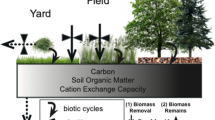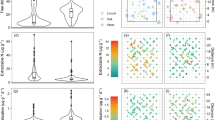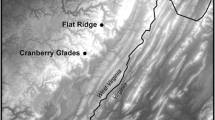Abstract
Increasing fertiliser use in agricultural landscapes is likely to threaten the viability of remnant native vegetation in many parts of the world. Australia’s prime grain production landscapes have nutrient poor soils, which formerly supported semi-arid woodland. The ecological function and capacity for regeneration of these remnants may be particularly susceptible to nutrient enrichment. The key sources of nutrients are wind and water deposition from crop fertilisation, and manure and feed from sheep. We hypothesised that these sources would result in unequal deposition of nutrients within and among remnant vegetation patches. We surveyed soil nutrients (Total N, Available P and K, C:N ratio, and soil pH) in the edges and interiors of 60 remnant woodland patches of various sizes, and in adjacent cultivated paddocks. Nutrient load was negatively correlated with remnant size and patterns were particularly strong for available P. Small remnant patches (<3 ha) were accumulation zones for nutrients, with levels comparable or higher than within crop lands. The patterns are consistent with the hypothesis that small remnants are strongly enriched as a result of being used for livestock shelter. In larger remnants, the primary cause of enrichment is consistent with edge accumulation of nutrients due to wind and water movement. In large patches, remnant edges, particularly the windward edge, were elevated compared to interiors of large patches. In these semi-arid crop lands, current trends in intensification of cropping and a shift away from livestock may reduce the input of nutrients to small patches but increase the nutrient threat to larger remnants.




Similar content being viewed by others
References
Bakker JP, Berendse F (1999) Constraints in the restoration of ecological diversity in grassland and heathland communities. Trends Ecol Evol 14:63–68
Bakker JP, van Diggelen R (2006) Restoration of dry grasslands and heathlands. In: van Andel J, Aronson J (eds) Restoration ecology: the new frontier. Blackwell Science, Oxford, UK
Bardgett RD, McAlister E (1999) The measurement of soil fungal:bacterial biomass ratios as an indicator of ecosystem self-regulation in temperate meadow grasslands. Biol Fert Soils 29:282–290
Beadle NCW (1966) Soil phosphate and its role in molding segments of the Australian flora and vegetation, with special reference to xeromorphy and scleromorphy. Ecology 47:92–1007
Bielders CL, Rajot J-L, Amadou M (2002) Transport of soil and nutrients by wind in bush fallow land and traditionally managed cultivated fields in the Sahel. Geoderma 109:19–39
Blumenthal DM, Jordan NR, Ruselle MP (2003) Soil carbon addition controls weeds and facilitates prairie restoration. Ecol Appl 13:605–615
Bolland MDA, Allen DG (2003) Increased P application to lateritic soil in 1976 increased colwell soil test P for P applied in 2000. Aust J Soil Res 41:645–651
Burnham KP, Anderson DR (2002) Model selection and multimodel inference: a practical information-theoretic approach. Springer-Verlag, New York
Cattle SR, Meakin SN, Ruszkowski P, Cameron RG (2003) Using radiometric data to identify aeoilian dust additions to topsoil of the Hillston district, western NSW. Aust J Soil Res 41:1439–1456
Colwell JD (1965) An automated procedure for the determination of phosphorus in sodium hydrogen carbonate extracts of soils. Chem Ind-London 21:893–895
Cook SE, Corner RJ, Groves PR, Grealish GJ (1996) Use of airborne gamma radiometric data for soil mapping. Aust J Soil Res 34:183–194
Donald CM (1963) Phosphorus in Australian agriculture. J Aust Inst Agric Sci 30:75–105
Dorioz JM, Wang D, Poulenard J, Trévisan D (2006) The effect of grass buffer strips on phosphorus dynamics—a critical review and synthesis as a basis for application in agricultural landscapes in France. Agr Ecosyst Environ 117:4–21
Dorrough J, Moxham C, Turner V, Sutter G (2006) Soil phosphorus and tree cover modify the effects of livestock grazing on plant species richness in Australian grassy woodland. Biol Cons 130:394–405
Ehrenfeld JG (2003) Effects of exotic plant invasions on soil nutrient cycling processes. Ecosystems 6:503–523
Groves RH, Keraitis K (1976) Survival and growth of seedlings of three sclerophyll species at high levels of phosphorus and nitrogen. Aust J Bot 24:681–690
Hejcman M, Klaudisova M, Stursa J, Pavlu V, Schellberg J, Hejcmanova P, Hakl J, Rauch O, Vacek S (2007) Revisiting a 37 years abandoned fertilizer experiment on nardus grassland in the Czech Republic. Agr Ecosyst Environ 118:231–236
Hilder EJ, Mottershead BE (1963) The redistribution of plant nutrients through free-grazing sheep. Aust J Sci 26:88–89
Hobbs RJ, Atkins L (1988) Effect of disturbance and nutrient addition on native and introduced annuals in plant communities in the Western Australian wheatbelt. Aust J Ecol 13:171–179
Hobbs RJ, Huenneke LF (1992) Disturbance, diversity and invasion: implications for conservation. Cons Biol 6:324–337
Hobbs R, Kristjanson LJ (2003) Triage: how do we prioritize health care for landscapes? Ecol Manage Restor 4:S39–S45
Huenneke LF, Hamburg SP, Koide R, Mooney HA, Vitousek PM (1990) Effects of soil resources on plant invasion and community structure in Californian serpentine grassland. Ecology 71:478–491
Janssens F, Peeters A, Tallowin JRB, Bakker JP, Bekker RM, Fillat F, Oomes MJM (1998) Relationship between soil chemical factors and grassland diversity. Plant Soil 202:69–78
Lange RT (1969) The piosphere: sheep tracks and dung patterns. J Range Manage 22:396–400
Larney FJ, Bullock MS, McGinn SM, Fryrear DW (1995) Quantifying wind erosion on summer fallow in southern Alberta. J Soil Water Cons 50:91–95
Lawes Agricultural Trust (2005) Genstat, 8th edn. VSN International, Hemel Hempstead, Hertfordshire, UK
Leys J, McTainsh G (1994) Soil loss and nutrient decline by wind erosion – cause for concern. Aust J Soil Water Cons 7:30–35
Mallee Catchment Management Authority (2003) Mallee regional catchment strategy 2003–2008. Mallee Catchment Authority, Mildura
Marrs RH (1985) Techniques for reducing soil fertility for nature conservation purposes: a review in relation to research at Roper’s Heath, Suffolk, England. Biol Cons 34:307–332
Matson PA, Parton WJ, Power AG, Swift MJ (1997) Agricultural intensification and ecosystem properties. Science 277:504–509
McIntyre S, Lavorel S (2007) A conceptual model of land use effects on the structure and function of herbaceous vegetation. Agr Ecosyst Environ 119:11–21
Morgan JW (1998) Patterns of invasion of an urban remnant of a species-rich grassland in southeastern Australia by non-native plant species. J Veg Sci 9:181–190
Okin GS, Gillette DA, Herrick JE (2006) Multi-scale controls on and consequences of aeolian processes in landscape change in arid and semi-arid environments. J Arid Environ 65:253–275
Passioura JB (2002) Environmental biology and crop improvement. Funct Plant Biol 29:537–546
Prober SM, Thiele KR, Lunt ID, Koen TB (2005) Restoring ecological function in temperate grassy woodlands: manipulating soil nutrients, exotic annuals and native perennial grasses through carbon supplements and spring burns. J Appl Ecol 42:1073–1085
Radford JQ, Bennett AF, Cheers GJ (2005) Landscape-level thresholds of habitat cover for woodland-dependent birds. Biol Cons 124:317–337
Rayment GE, Higginson FR (1992) Australian laboratory handbook of soil and chemical methods. Inkata Press, Melbourne
Schall R (1991) Estimation in generalised linear models with random effects. Biometrika 78:719–727
Silvertown J, Dodd ME, McConway K, Potts J, Crawley MJ (1994) Rainfall, biomass variation and community composition in the park grass experiment. Ecology 75:2430–2437
Standish RJ, Cramer VA, Hobbs RJ, Kobryn HT (2006) Legacy of land-use evident in soils of Western Australia’s wheatbelt. Plant Soil 280:189–207
Sweeney RA, Rexroad PR (1987) Comparison of leco-fp-228 nitrogen determinator with aoac copper catalyst kjeldahl method for crude protein. J Assoc Off Ana Chem 70:1028–1030
Taylor JA, Hedges DA (1984) Some characteristics of the trees used by sheep for diurnal camping and differences between shade and nocturnal camps in a paddock on the northern tablelands of New South Wales. Aust Rangeland J 6:3–9
Taylor JA, Robinson GG, Whalley RDB (1987) Camping and faeces distribution by merino sheep. Appl Anim Behav Sci 17:273–288
Thomson VP, Leishman MR (2004) Survival of native plants of Hawkesbury Sandstone communities with additional nutrients: effects of plant age and habitat. Aust J Bot 52:141–147
Tilman D, Fargione J, Wolff B, D’Antonio CM, Dobson A, Howarth R, Schindler D, Schlesinger WH, Simberloff D, Swackhamer D (2001) Forecasting agriculturally driven environmental change. Science 292:281–284
Tilman D, Cassman KG, Matson PA, Naylor R, Polasky S (2002) Agricultural sustainability and intensive production practices. Nature 418:671–677
Verhagen R, Klooker J, Bakker JP, van Diggelen R (2001) Restoration success of low-production plant communities on former agricultural soils after top-soil removal. Appl Veg Sci 4:75–82
Walker KJ, Warman EA, Bhogal A, Cross RB, Pywell RF, Meek BR, Chambers BJ, Pakeman R (2007) Recreation of lowland heathland on ex-arable land: assessing the limiting processes on two sites with contrasting soil fertility and pH. J Appl Ecol 44:573–582
Walkley A, Black IA (1934) An examination of the degtjareffmethod for determining soil organic matter and a proposed modification of the chromic acid titration method. Soil Sci 37:29–38
Wassen MJ, Venterink HO, Lapshina ED, Tanneberger F (2005) Endangered plants persist under phosphorus limitation. Nature 437:547–550
White M, Oates A, Barlow T, Pelikan M, Brown J, Rosengren N, Cheal D, Sinclair S, Sutter G (2003) The vegetation of north-west Victoria: a report to the Wimmera, North Central and Mallee catchment management authorities. Arthur Rylah Institute for Environmental Research, Melbourne
Wilford JR, Bierwirth PN, Craig MA (1997) Application of air-borne gamma-ray spectrometry in soil/regolith mapping and applied geomorphology. ASGO J Aust Geol Geophys 17:201–216
Wilson SD, Tilman D (1993) Plant competition and resource availability in response to disturbance and fertilization. Ecology 74:599–611
Wolfe SA, Nickling WG (1993) The protective role of sparse vegetation in wind erosion. Progr Phys Geog 17:50–68
Wright IJ, Westoby M (2003) Nutrient concentration, resorption and lifespan: leaf traits of Australian sclerophyll species. Funct Ecol 17:10–19
Acknowledgments
We thank Pierre Compere, Huon Stephens, Louise Grgat, Cassia Read and Lucy Simnett for field assistance. Soil analyses were performed by CBSP Laboratories, Bibra Lake, Western Australia. Numerous Landholders and Parks Victoria allowed us to conduct surveys on their properties. This manuscript was improved by the comments of Libby Rumpff and two anonymous reviewers. This project was supported by the North Central and Mallee Catchment Management Authorities through the Natural Heritage Trust and the National Action Plan for Salinity and Water Quality, and the Victorian State Government initiative “Our Rural Landscapes”.
Author information
Authors and Affiliations
Corresponding author
Rights and permissions
About this article
Cite this article
Duncan, D.H., Dorrough, J., White, M. et al. Blowing in the wind? Nutrient enrichment of remnant woodlands in an agricultural landscape. Landscape Ecol 23, 107–119 (2008). https://doi.org/10.1007/s10980-007-9160-0
Received:
Accepted:
Published:
Issue Date:
DOI: https://doi.org/10.1007/s10980-007-9160-0




